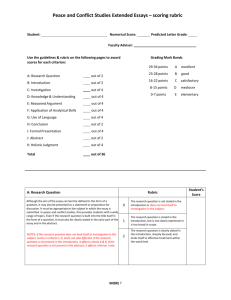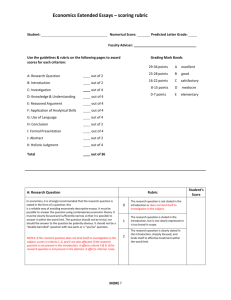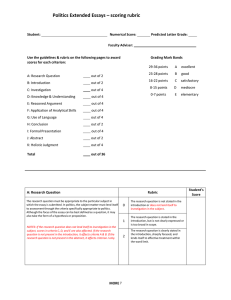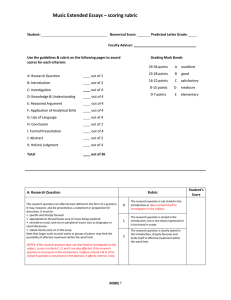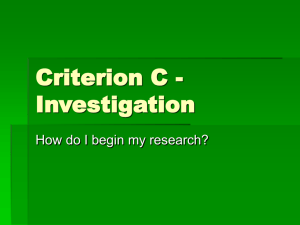Human Rights scoring rubric
advertisement
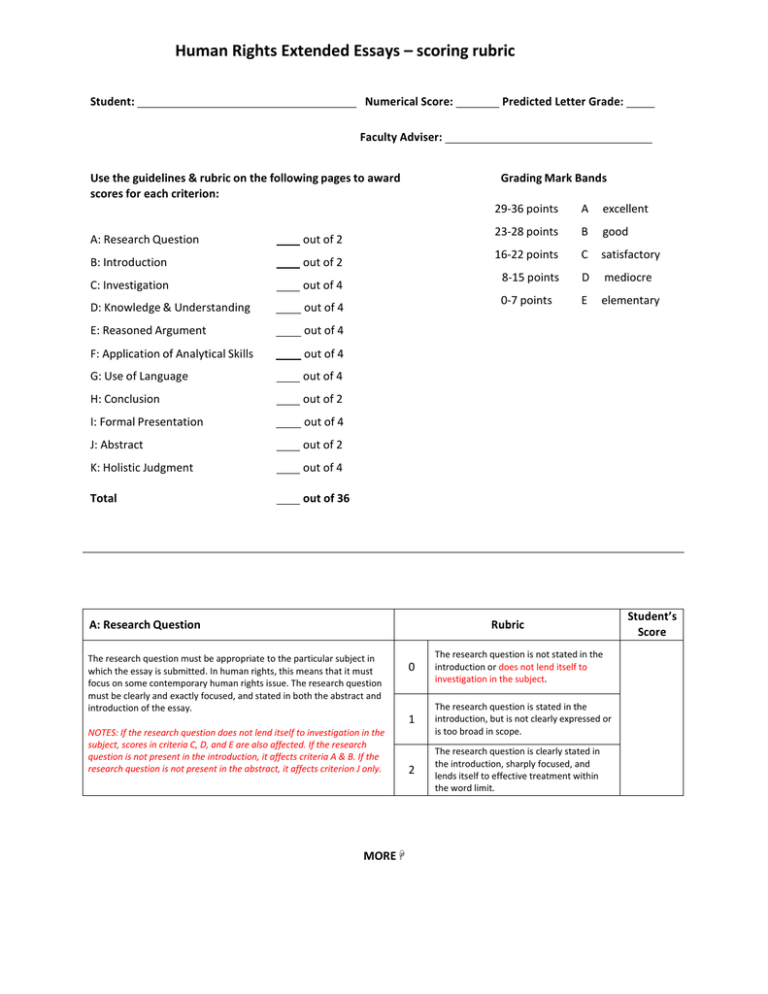
Human Rights Extended Essays – scoring rubric Student: Numerical Score: Predicted Letter Grade: Faculty Adviser: Use the guidelines & rubric on the following pages to award scores for each criterion: A: Research Question out of 2 B: Introduction out of 2 C: Investigation out of 4 D: Knowledge & Understanding out of 4 E: Reasoned Argument out of 4 F: Application of Analytical Skills out of 4 G: Use of Language out of 4 H: Conclusion out of 2 I: Formal Presentation out of 4 J: Abstract out of 2 K: Holistic Judgment out of 4 Total out of 36 Grading Mark Bands A: Research Question 29-36 points A excellent 23-28 points B good 16-22 points C satisfactory 8-15 points D mediocre 0-7 points E elementary Rubric The research question must be appropriate to the particular subject in which the essay is submitted. In human rights, this means that it must focus on some contemporary human rights issue. The research question must be clearly and exactly focused, and stated in both the abstract and introduction of the essay. NOTES: If the research question does not lend itself to investigation in the subject, scores in criteria C, D, and E are also affected. If the research question is not present in the introduction, it affects criteria A & B. If the research question is not present in the abstract, it affects criterion J only. 0 The research question is not stated in the introduction or does not lend itself to investigation in the subject. 1 The research question is stated in the introduction, but is not clearly expressed or is too broad in scope. 2 The research question is clearly stated in the introduction, sharply focused, and lends itself to effective treatment within the word limit. MORE Student’s Score B: Introduction Rubric The introduction should explain succinctly the significance and context of the topic, why it is worthy of investigation, what the key concepts are and how the research question relates to existing knowledge. A good introduction also provides an outline of the essay and may contain a hypothesis. It should not contain irrelevant background material. 0 The research question is not placed in context and the significance of the topic is not explained in the introduction. 1 Attempt is made to place the research question in context and to explain the significance, stating why the topic is worthy of investigation. 2 The research question’s context is clear, as is the significance of the topic and why it is worthy of investigation. C: Investigation Rubric The range of resources is influenced by various factors, but above all by the topic. Students should aim to use sources that present different theoretical approaches, as well as those that enable human rights issues to be understood from different cultural perspectives. All material used from sources must be acknowledged in references. If students make use of internet-based sources, they should do so critically and circumspectly in full awareness of their potential unreliability. 0 Little or no evidence that sources have been consulted, data gathered, or that planning has taken place. 1 Sources used and/or data gathered are inappropriate. Little or no evidence of planning the investigation. 2 Limited range of appropriate sources and/or data; some relevant material selected; some level of planning evident. 3 Sufficient range of appropriate sources and/or data; relevant material selected; satisfactory planning is evident. 4 Imaginative range of appropriate sources and/or data; relevant material carefully selected; well-planned investigation. D: Knowledge & Understanding Rubric Students should aim to demonstrate knowledge and understanding of human rights theories, issues and practices. Students should also demonstrate their awareness of cultural contexts and biases that often affect the ways that human rights theories, issues and practices are explained. 0 1 2 Student’s Score (A maximum of 2 may be awarded if the research question does not lend itself to investigation in this subject.) Student’s Score No real knowledge or understanding of the topic studied. Some knowledge but little understanding of the topic. Little awareness of an academic context for the investigation. Adequate knowledge and some understanding of the topic. Some awareness of academic context for the investigation. 3 Good knowledge and understanding of the topic. Successfully outlines the academic context for the investigation. 4 Very good knowledge and understanding of the topic. Clearly and precisely grounds the investigation in an academic context. MORE Student’s Score (A maximum of 2 may be awarded if the research question does not lend itself to investigation in this subject.) E: Reasoned Argument Rubric Students should aim to present their ideas in the form of a logical and coherent argument that is relevant to the research question. Ideas should be substantiated with factual evidence and examples. Straightforward descriptive or narrative accounts that lack analysis do not usually advance an argument and should be avoided. 0 No attempt to develop a reasoned argument in relation to the research question. 1 Limited or superficial attempt to present ideas logically/coherently and to develop a reasoned argument. 2 Some attempt to present ideas logically/coherently and develop a reasoned argument, with only partial success. 3 Ideas are presented logically/coherently, along with reasoned argument, but with some weaknesses. 4 Ideas are presented clearly, logically and coherently; successful in developing a reasoned, convincing argument. F: Application of Analytical & Evaluative Skills Rubric Students should demonstrate their analytical skills by identifying premises, assumptions, and possible hidden agendas and biases linked to human rights theories and practices. They should be able to deconstruct arguments related to these theories and practices, and evaluate to what extent agents who claim to support particular principles are applying them in practice. Because human rights issues are often contested and it is not uncommon for biased views to be presented, students should pay special attention to the evaluation of sources. They should avoid unjustified and subjective value judgments regarding human rights issues, but be able to evaluate how theories and practices link to concepts of justice and equality. 0 No application of appropriate analytical and evaluative skills. 1 Little application of appropriate analytical and evaluative skills. 2 Some application of appropriate analytical and evaluative skills, which may be only partially effective. 3 Sound application of appropriate analytical and evaluative skills. 4 Effective and sophisticated application of appropriate analytical and evaluative skills. G: Use of Language Rubric The language used should be clear, unambiguous and precise. Terminology specific to human rights should be used wherever possible to communicate ideas efficiently. Sweeping generalizations, unsupported assertions, overly subjective value judgment and biased language should all be avoided. This criterion is not meant to disadvantage students who are not writing in their first language—as long as the meaning is clear, the subject content will be rewarded. 0 1 2 3 4 MORE Language is inaccurate and unclear. No effective use of terminology appropriate to the subject. Language sometimes communicates clearly, but not consistently. Terminology is only partially accurate. Language & terminology usually communicate clearly and accurately. Language communicates clearly. Terminology is accurate, although there may be occasional lapses. Language is clear and precise. Terminology is appropriate, used accurately and with skill and understanding. Student’s Score (A maximum of 2 may be awarded if the research question does not lend itself to investigation in this subject.) Student’s Score Student’s Score H: Conclusion Rubric The conclusion of a human rights extended essay should reflect the evidence and argument presented in the body of the essay. It should also, if possible, provide a direct answer to the research question or address the hypothesis. If the research did not support the original hypothesis, this should be pointed out in the conclusion. The conclusion should also, where appropriate, comment on the limits of the validity of the conclusion, given the scope of research. 0 1 2 I: Formal Presentation This criterion relates to the extent to which the essay conforms to academic standards about the way in which research papers should be presented. The presentation of essays that omit a bibliography or that do not give references for quotations is deemed unacceptable (level 0). Essays that omit one of the required elements—title page, table of contents, page numbers—are deemed no better than satisfactory (maximum level 2), while essays that omit two of them are deemed poor at best (maximum level 1). Unacceptable formal presentation; or essay exceeds 4,000 words. 1 Poor formal presentation. 2 Satisfactory formal presentation. 3 Good formal presentation. 4 Excellent formal presentation. Rubric 0 hypothesis), the scope of the essay (that is, what was investigated and how it was investigated) and the conclusion. An abstract is not a precis of the topic. 1 2 K: Holistic Judgment Qualities that are rewarded under this criterion include the following. Intellectual initiative: Ways of demonstrating this in human rights essays include producing new knowledge based on original research (such as interviews), interpreting data from a human rights perspective or interpreting human rights theories, issues and practices in an original way. Insight and depth of understanding: These can be demonstrated by producing original, well-justified and substantiated arguments that directly address the research question. Routine essays on well-worn topics will not score highly under this Clearly-stated, effective conclusion; relevant, consistent with evidence, and includes any unresolved questions. 0 The abstract must consist of three elements: the research question (or The abstract is judged on the clarity with which it presents the three required elements, not on the quality of the research question itself, nor on the quality of the argument or the conclusions. Little or no attempt to provide a conclusion relevant to the research question. Attempt to provide conclusion relevant to the research question, but not entirely consistent with presented evidence. Rubric J: Abstract Student’s Score Student’s Score Student’s Score Abstract exceeds 300 words, or is missing one or more of the required 3 elements. Abstract contains all 3 required elements, but they are not clearly stated. Abstract includes all 3 required elements, and they are clearly stated. Rubric 0 No evidence of initiative, creativity, or insight. 1 Little evidence of initiative, creativity, or insight. 2 Some evidence of initiative, creativity, insight. 3 Clear evidence of initiative, creativity, insight. 4 Considerable evidence of initiative, creativity, insight. Student’s Score
